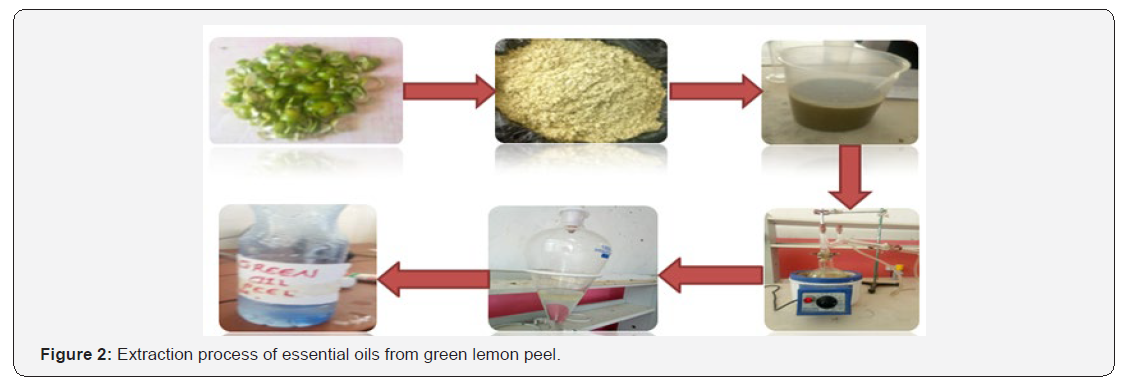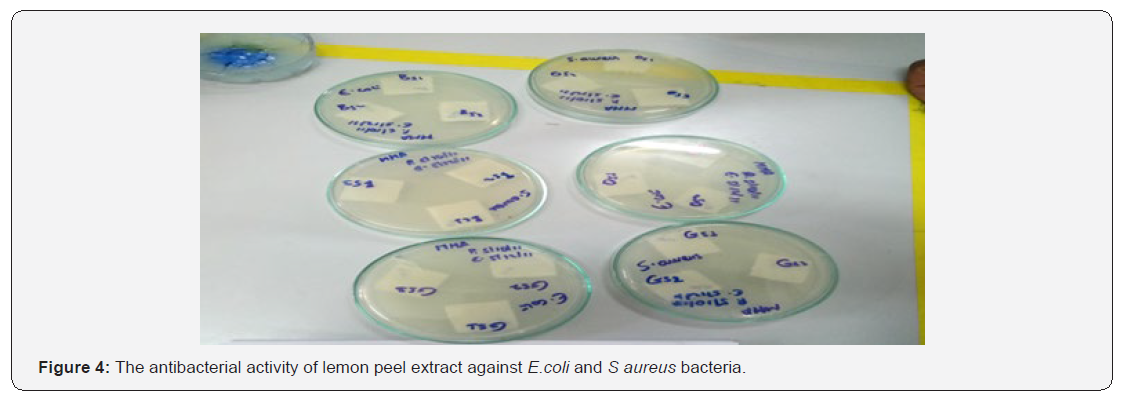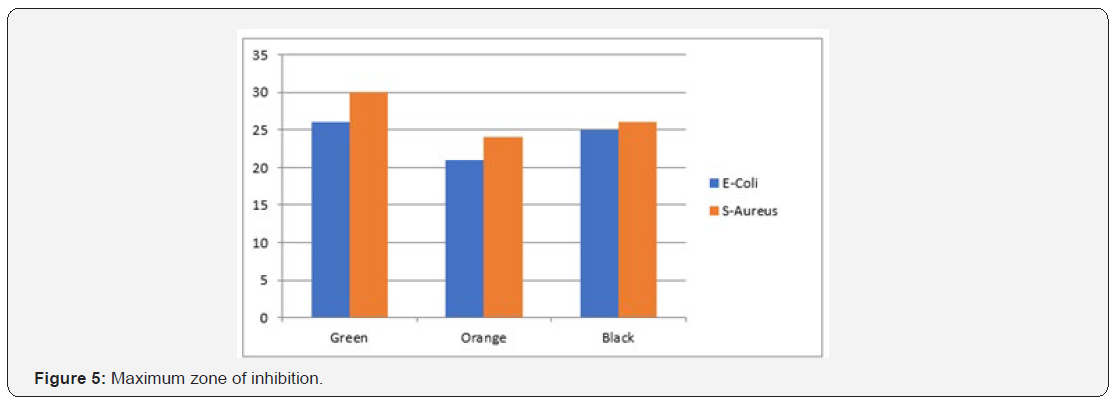Fashion Technology & Textile Engineering - Juniper Publishers
The objective of this study is to explore, evaluate
and compare the antibacterial activity of a cotton fabric treated with
essential oils extracted from green, orange & black (a mixture of
both green and orange) lemon peel (Citrus limon). The Citrus limon peel
is rich in nutrient such as flavonoid and essential oil that can be used
for antimicrobial activity. The finishing agent, lemon peel extract was
extracted by treatment with methanol using steam distillation
techniques. The antimicrobial activities were evaluated against
Staphylococcus aureus (gram-positive) and Escherichia coli
(gram-negative) bacteria by zone of inhibition measurement. Cotton
finished with green lemon peel extract showed strong antimicrobial
activities against Staphylococcus aureus (24-30mm) and Escherichia coli
(22-26mm) bacteria as compared to orange and black lemon. Black (50%
green and 50% orange) lemon peel extract showed better antimicrobial
activities against Staphylococcus aureus (18-26mm) and Escherichia coli
(18-25mm) bacteria than the orange lemon peel. In addition to this, the
durability of the natural finishing agent on cotton was measured before
or after washing and has got the same effect. From this study, it was
revealed that citrus lemon have better, durable antibacterial potential
with the green lemon peel extract having a more efficient effect
compared to others.
Keywords: Antibacterial; Lemon peel; Essential oil; Zone of inhibition; Cotton fabric
Introduction
The antimicrobial finishing process imparts the
ability, to textile substrate, to inhibit the growth (-static) or
reproduction of at least some types of microorganisms or to kill
(-cidal) at least some types of microorganisms” [1-3]. Therefore, an antimicrobial finish should be
capable to kill the microbes by breaching the cell wall or alter cell
membrane permeability, obstructing the synthesis of proteins of
microbes, blocking enzyme production necessary for microbes’ food [1].
The major use of the antimicrobial was in the medical and the
pharmaceutical industry. However, newer applications are possible. The
textile fibers are these days increasingly treated with antimicrobial
reagents. The other examples include the applications in food packaging
and food storage, and medical, surgery and hygienic products etc [4-6].
With the improvement of life standards, the demand of hygienic products
is increasing for biocidal finishes in textiles (sports-wears,
undergarment, bedlinen) and water filtration. The antibacterial finish
treatment has become vital area of medical, surgical and healthcare
activities due potential pathogenic microorganisms present in hospital
environment and cause cross-infection diseases [7-11]. The types of
micro-organisms include different kinds of organisms such as
virus, bacteria, unicellular plants and animals, certain algae and
fungi [12]. Classification in bacteria family is “gram- positive,
gram-negative, spore bearing or non-spore bearing type”. Some of the
bacteria are of pathogenic nature that may cause infections to human
[13].
A gram-positive bacterium contains peptidoglycan and
teichoic acid, peptidoglycan comprises of 90% of cell walls and made of
amino acid and sugar. One example of gram-positive bacteria is
Staphylococcus aureus (S.aureus) that is in form of pair, short chain or
graphic like cluster. Its size range is 0.5μm to 1.0μm and grows in
temperature range of 35 to 40°C. S aureus is major cause of cross
infection in hospital environment and 19% of total surgical infection.
It’s also responsible for boils and also cause scaled skin infections.
Gram-negative bacteria are firm to reduce as compared to gram positive
bacteria for the reason that of extra cell walls. An example of
gram-negative bacteria is Escherichia coli (E. coli); its shape is
similar to a bacillus and dwell in intestine of human. E. coli can be
proliferated during eating and/or usage of raw food stuff [13].
Antimicrobials control the growth of microorganisms and their negative
effects of odour, staining and deterioration. Antimicrobial finishing
prevents or inhibits the growth of microorganisms or microbes. The
enormous majority of antimicrobials work by leaching or moving from the
surface on which they are applied [14-16]. Most modern antimicrobial
finished textiles are based on synthetic
products, and current consumer demands must be correlated with
obtaining environmental friendly final products. Conventional
antimicrobial finishing includes treatment with quaternary
ammonium compounds, triclosan, N-halamines, poly biguanides,
nanoparticles of noble metals (nanosilver treatment) and metal
oxides [17,18] but also treatment with titanium oxide doped with
various elements for photocatalytic and antimicrobial induced
properties.
New trend in antimicrobial finishing promotes plant-based
dyes [19] over synthetic ones that can also act as antimicrobial
agents [20]. Plant extracts provided an attractive source of
eco- friendly antimicrobial finish. The natural cure using plant
extracts is increasingly receiving interest in the development of
antimicrobial textiles. Plant extracts can be used as finishing agents during textile
processes or can be encapsulated for inducing controlled
release properties (acacia based capsule wall filled with herbal
extracts [21]. Current researches regarding use of various plants
extracts for the treatment of antimicrobial finished fabrics
include functionalization of 100% cotton bed linen fabric with
neem (Azadirachta indica) and Mexican daisy extracts [22],
fabrics treated with turmeric rhizomes extract (Curcuma longa)
pomegranate fruit rinds extract (Punica granatum), aloe vera
extract [23], tea oil, eucalyptus oil, tulsi leaves extract, with
high antimicrobial efficiency [24] against a series of fungi and
Gram-positive and Gram-negative bacteria [25]. Beside extracts
treatment, bioactive functionalisation of textile fibers includes
compounds such as phenolic and polyphenols, alkaloids, lectins,
poypeptide, polyacetylene, terpenoids etc [26]. Although the
antimicrobial properties of various plants extracts has been
thoroughly researched, the antimicrobial active functionalization
of textile materials using plants extracts still require intensive
documentation.
Lemon (Citrus sinensis) peel is an agro-horticultural waste
produced in huge quantities from various fruit processing
industries. It is normally discarded and dumped in the environment
that can create environmental concerns [27,28]. Citrus limon
belongs to Rutaceae family; its common name is lemon and this
originated from South East Asia, probably in India or Southern
China. Lemon is a pale yellow, elliptical or globe shaped berry
fruit. Citrus fruit, in general contain sugar, polysaccharide,
organic-acid, lipids, carotenoids, vitamins, minerals, flavonoids,
bitter lemonoids and volatile compounds. Lemon is a good source
of potassium, calcium & vitamin C. Limon or lime juice have
been reported to exhibit antimicrobial activity against Vibrio
cholera [29, 30]. Citrus by-products, if utilized fully, could be
major sources of phenolic compounds. The peels, in particular,
are an abundant source of natural flavonoids, and contain higher
amount of phenolics compared to the edible portions. It has been
reported that the contents of total phenolics in peels of lemons,
oranges, and grapefruit were 15% higher than those in the peeled
fruits [27,31]. Flavonoids in citrus are a major class of secondary
metabolites. The peel contains the highest amount of flavonoids
than other parts and those flavonoids present in citrus fruits
belong to six peculiar classes according to their structure. They
are: flavones; flavanones; flavonols; is of lavones; anthocyanidins
and flavanols [31].
Recent research suggests that citrus fruits possess another
health benefit phytochemicals called limonoids, highly oxygenated
triterpenoid. Citrus limonoids appear in large amounts in citrus
juice and citrus tissues as water soluble limonoid glucosides or
in seeds as water insoluble limonoid aglycones. The limonoid
aglycones are responsible for the development of delayed
bitterness in citrus and are converted to the non-bitter limonoid
glucosides during fruit maturation [27]. The objective of the
present work is imparting antimicrobial finish on cotton by using
natural fruit peel extract to fabric and to reduce the effect of
microorganism on human body and a fabric.
Materials and Methods
Materials and Chemicals
Lemon fruits (Citrus sinensis) were obtained from local
Ethiopian market. The lemon peels were collected immediately
after the fruit was peeled. Full bleached plain cotton fabric with
24 ends per inch, 18 picks per inch and having a GSM of 142g/
m2 supplied by Kombolcha Textile Share Company was used. All
chemicals used were of analytical-reagent grade and obtained
from Chemical Engineering Laboratory (KIOT, Ethiopia).
Experimental Procedure

In this study the following experimental procedure was
followed to finishes cotton with ant-bacterial by treatment with
essentials oils of lemon peels (Figure 1).
Preparation of lemon peel
The lemon peels were obtained from the local juice vendors in
Kombolcha (Ethiopia). The fruits collected from local market must
be fresh and not affected bacteria before then it will change the
properties of microbes during application and testing. The peels
were sorted, cleaned and washed in sterile distilled water, air
dried and peeled off further; the peels were dried in sun, packed
in envelops for drying in hot air oven at 65℃ for 3 days and used
as raw material for the extraction of antimicrobial compounds.
Methods of Extraction of Essential Oil
Essential oils were obtained by steam distillation from lemon
peels. Steam distillation was preferred to direct extraction by
heating, in order to avoid loss and denaturation of constituent
chemicals. The cotton fabric was treated by impregnation with
essential oils of orange and green colored lemon peel separately.
In this study three different essential oils was extracted from
orange, green and black (mixture of orange and green) lemon peel
(Table 1).

Extraction Mechanism of Essential Oil from Lemon Peel
A green and orange colored lemon was used in this study to
extract essential oil for coating of cotton fabric in order to impart
antibacterial finish to cotton. Steam distillation techniques were
used for extraction of the essential oils from lemon. The essential
oils were separated from water using density separator methods.
The extraction process for the green lemon and orange lemon was
presented in (Figures 2&3) respectively.


Optimization of Application Conditions
Pad-dry-cure technique was used in this study to apply the
extracted essential oils onto cotton fabric. Optimization of the
pad-dry-cure process was done by varying squeezing pressure,
drying temperature, drying time, curing temperature and curing
time during the application of the essential oils on cotton. For
finishing of the extracted natural antimicrobial agent on cotton
optimization of application conditions were tried at 60, 70, 80,
90 and 100℃ of drying temperature; 3, 5, 7, 9 and 11 minutes of
drying time; 120, 130, 140 150 and 160℃ of curing temperature;
1, 2, 3, 4 and 5 seconds of curing time. This optimization process
was done separately for green, orange and black lemon peel types.
Throughout this study, all the samples and results presented are
at the optimized applications conditions after a number of trials.
Evaluation of Antimicrobial Activities
The antimicrobial activity of the samples was tested against
E.coli as gram negative bacteria and S.aureus as gram-positive
bacteria. The antibacterial activity was tested by means of
liquid (turbidity evaluation) and solid medium (agar diffusion)
antibacterial using nutrient broth medium [32,33]. Antibacterial
finishes on cotton fabric was assessed according to AATCC 100-
2004 standard test method. Test specimens were cut in 4.8 +0.1 cm
diameter using a steel die. 100μl working culture inoculated test
specimens, individually in sterile Petri plates. After inoculation,
specimen were placed screw cap jar contained 100ml neutralizing
agent. The toxicity of neutralizing agent against tested organisms
was reexamined and no toxicity was determined. Jars were shaked
vigorously for one minute, serial dilutions were made. From each
of three suitable dilutions, 0.1ml liquid was drawn and transferred
to TSA [34]. The number of survivors was determined after
48 hour incubation at 37°C by counting the colonies as colony
forming units per millimeter (CFU/ml) using a colony counter
device (Acolyte Super colony Counter, Symbiosis). Furthermore,
additional jars were prepared to provide information about the
bactericidal activity of treatment over contact period (60 minutes).
Durability is tested by two ways, by washing and by zone of
inhibition. The durability of antimicrobial activity by washing
is one of the major concerns of textile researchers and users
because textiles are subjected to frequent laundering. The
antimicrobial activity of the finished samples was evaluated after
being subjected to several wash cycles by ISO: 6330.2012E. In this
investigation 5 times washing cycles was used for durability test
throughout the whole observation. The content of lemon (Citrus
Limon) peel in antimicrobial textile before or after washing was
measured and has got the same effect [35]. This is the reason that
the antimicrobial textile treated with lemon (Citrus Limon) peel
had good antimicrobial ability after 5 times washing cycles and
also implied that even only small quantity of essential oil extracted
from lemon peel existed on fabrics would offer a good inhibition
to E coli and S aureus.
Results and Discussion
In this research work, the antibacterial activities of orange and
green colored lemon peel extract were determined and compared
by finishing cotton fabric. The result shows the antimicrobial
activity on cotton fabric after 5 washing cycles. The gram
positive and gram-negative bacteria were taken to observe their
effectiveness and since they behave differently for citrus lemon
finishes.
Extraction of the Essential Oil
The same procedure and parameters were used to extract
the essential oils from the green and orange colored lemon. 10
grams of each plant materials were dissolved separately in 100ml
of distilled water with 10ml of methanol and heated at 100℃ for
75 minutes. In this steam distillation technique of finishing agent
extraction the essential oil was separate from water using density
separator.
Optimization of the Application Conditions
Coating of cotton with natural finishing agent obtained from
lemon peel extract were carried out at different application
conditions in order to determine the maximum inhibition zone
and minimum scorching of the fabric. More effective antibacterial
activities were obtained at the optimal parameters in the pad-drycuring
process and the results were presented in Table 2.

Antibacterial Activity of Lemon (Citrus Limon) Peel Extract
The lemon (Citrus Limon) peel extract were determined
for their antibacterial activity against E. coli and S.aureus using
muller hinton agar (MHA) method (Figure 4). Diameter of
inhibition zone of lemon (Citrus Limon) peel extract was shown
in Table 3. From Table 3 and Figure 5, it was observed that the
antibacterial activities of green lemon peel extract finished cotton
showed higher effectiveness in both gram-negative (E.coli) and
gram-positive (S.aureus) than orange and black lemon. (Figure
5&6) indicate the maximum and minimum zone of inhibitions
against both types of bacteria respectively. Cotton sample which
was finished with green lemon peel is more effective under E.coli
types of bacteria by 22-26 mm zone of inhibition and under
S.aureus bacteria by 24-30mm zone of inhibition. This result
showed that maximum zone of inhibition against both types of
bacteria was observed by finishing of cotton with green lemon
peel extract. However, the antimicrobial activity of black (mixture
of green and orange) lemon peel extract finished cotton sample
showed better effect than the orange lemon peel extract treated
cotton in both under E. coli types of bacteria by18-25mm and
under S.aureus bacteria by 18-26mm zone of inhibition. The black
sample which compose a mixture of 50% green and 50% orange
lemon peel was more effective than 100% orange lemon because
of the combinational effect.



Conclusion
In this study, the antibacterial activities of green, orange
and black colored lemon was discussed and compared. The
result shows that the coating of cotton using lemon peel extracts
have good antimicrobial activity against Escherichia coli and
Staphylococcus aureus bacteria. Green lemon peels extract
finished cotton showed strong antimicrobial activity against these
bacterial. Finishing of cotton using natural plant products waste
like lemon peel has high potential to exhibit antimicrobial activity.
Click here: https://juniperpublishers.com/ctftte/index.php
To Know more about our Juniper Publishers
To Know more about our Juniper Publishers





I wasted a lot of money trying to find the right medication for my moms dementia all to no avail until Dr Erayo showed up and eradicated the stigma with the natural roots and herbs i ordered from him , my mom took it for 21days and she was cured from her dementia.
ReplyDeleteGod have use Dr Erayo herbal home to cure my mom, thank you so much Dr Erayo I am so happy. You can email Dr Erayo for help drerayoherbalhome@gmail.com
or whatsapp him on +2348151937428
website---- https://alternativeherbs.weebly.com
Youtube link---- https://www.youtube.com/channel/UCSp2m-_EHnCRQT4gYYTQWtg
FB page---- https://rb.gy/yuofn6